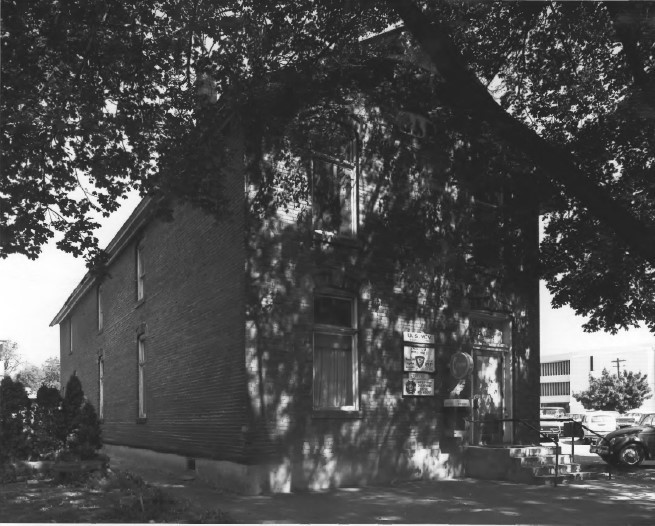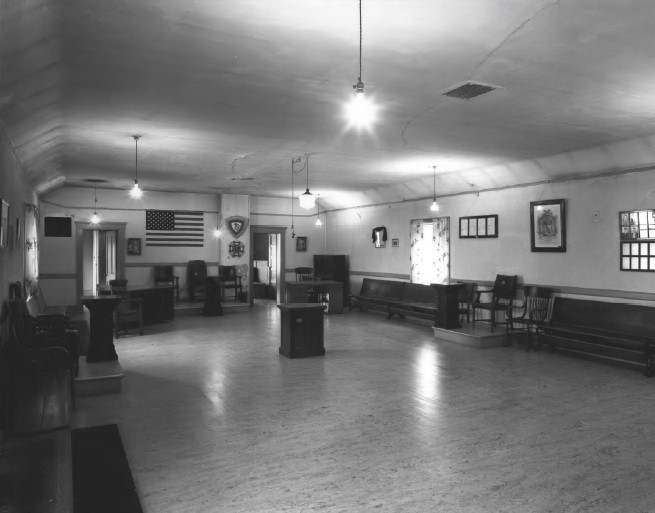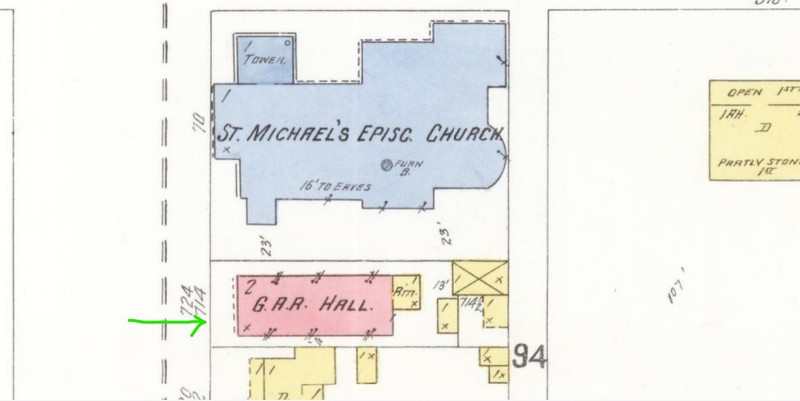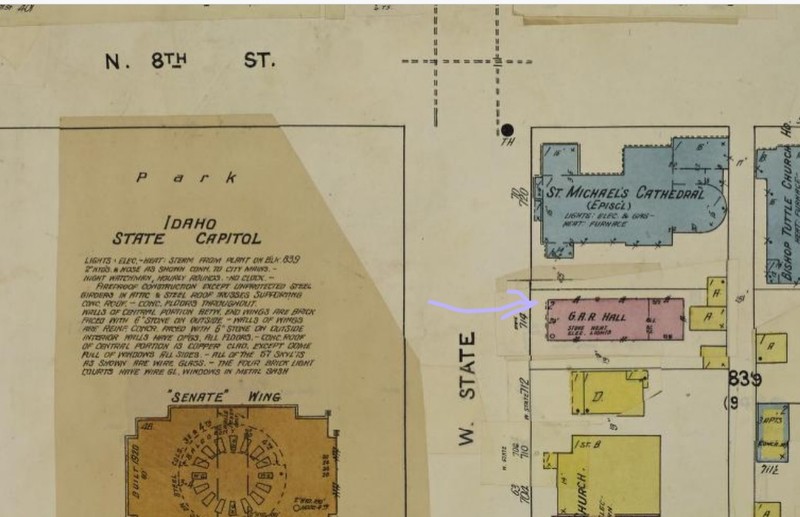GAR Hall
Introduction
Text-to-speech Audio
Built in 1892 as a meeting place for a local chapter of the Grand Army of the Republic (GAR), an organization of Union veterans of the Civil War, GAR Hall is on W. State St., northwest of the Idaho State Capitol building. The two-story brick building has a front gable with a sandstone block set into the brick below with the incised lettering "G. A. R." The building was designed to hold two large meeting halls, with one on each floor. GAR Hall was added to the National Register of Historic Places in 1974 for its significance in architecture and social history. The building was adapted into a photographic studio in the 1970s and has been leased as administrative offices by the University of Idaho since the early 2000s. GAR Hall is owned by its neighbor, St. Michael's Cathedral.
Images
Front and west side of GAR Hall in 1973 NRHP photo (Duane Garrett)

Interior hall on second floor of GAR Hall, looking north, in NRHP photo in 1973 (Garrett)

GAR Hall (green arrow) on 1903 Sanborn map (p. 14)

GAR Hall (purple arrow) behind Senate Wing of State Capitol on 1949 Sanborn map (p. 50)

Backstory and Context
Text-to-speech Audio
The Grand Army of the Republic was an organization formed for Union Civil War veterans with three objectives: fraternity, charity, and loyalty. The idea for the group came from Benjamin Franklin Stephenson, an Army surgeon from the Fourteenth Illinois Infantry. The first post was chartered in April 1866 at Decatur, Illinois with twelve members. In a few months, dozens of other posts were formed in Illinois. The idea quickly spread to other states, and by the first national GAR convention in November 1866 in Indianapolis, members hailed from the District of Columbia and ten states: Illinois, Indiana, Iowa, Kansas, Kentucky, Missouri, New York, Ohio, Pennsylvania, and Wisconsin. The veterans chose General Stephen A. Hurlbut of Illinois as their first commander-in-chief. The second national encampment was held in Philadelphia in 1868, where General John A. Logan of Illinois was elected to head the organization. One of the later commanders-in-chief was General Ambrose E. Burnside of Rhode Island, whose facial hair was the origin of the term "sideburns."
The GAR became increasingly involved in politics, especially in lobbying the federal government for veterans' causes. At its peak in 1890, before many veterans succumbed to old age, The GAR contained 400,000 members in 7,000 posts. Five American presidents were GAR members: Union General Grant, Hayes, Garfield, Harrison, and McKinley. There were still 5,000 posts when the GAR celebrated its fiftieth anniversary in 1916. The GAR officially disbanded in 1949; the last member died at age 109 in 1956.
The GAR Hall in Boise was built for the Phil Sheridan chapter of the GAR, named for a Union Civil War general who helped turn the tide to win the Battle of Cedar Creek in Middletown, Virginia in October 1864. Construction began in October 1891 and was completed in January 1892. The official name for the new Boise building was the Phil Sheridan GAR post no. 4. It became one of thirty-four GAR buildings constructed in Idaho.
GAR Hall originally measured 80 feet on the sides and 35 feet on the front and back. The front gable features band-sawn wood trim above a sandstone block with the lettering "G. A. R." carved into it. Carved keystones in segmental arches top the sash windows and single front door of the main facade. The first and second floors were each designed to hold a large hall. There are small anterooms in the ends of the building as well as front and back stairways. To give a slightly taller ceiling, the second-story hall's ceiling is coved to conform to the roof. The fairly simple building was the work of a contractor named William Houtz who formerly built mainly large timber structures for mining camps. Electricity and plumbing weren't added to the building until 1897 when the structure was five years old.
Duane W. Garrett. who took many of the black and white official photos of Boise buildings listed in the National Register of Historic Places in the 1970s, purchased GAR Hall in 1973. It had been one of the last GAR posts that was still in the hands of veterans' organizations. Garrett planned to preserve the exterior while adapting the interior for his commercial photographic studio. The open halls were divided into smaller office spaces, and a rear two-story addition was built that contained bathrooms and a kitchen.
Sources
American Battlefield Trust. Philip Sheridan, Civil War: Biography. Accessed January 31st, 2023. https://www.battlefields.org/learn/biographies/philip-sheridan.
Anonymous. "Grand Army of the Republic Fifty Years Old Today." Evening Capital News (Boise) April 6th, 1916. 1-1.
Hart, Arthur A. NRHP nomination of GAR Hall, Boise, Idaho. National Register. Washington, DC. National Park Service, 1973.
Preservation Idaho. GAR Building, Idaho Architecture Project. January 1st, 2023. Accessed January 31st, 2023. https://www.idahoarchitectureproject.org/properties/gar-building/.
Smith, Arthur E., Jr. Grand Army of the Republic and Kindred Societies, Library of Congress: Research Guides. June 9th, 2022. Accessed January 31st, 2023. https://guides.loc.gov/grand-army-of-the-republic.
National Park Service (NPS): https://npgallery.nps.gov/AssetDetail/NRIS/74000727
NPS: https://npgallery.nps.gov/AssetDetail/NRIS/74000727
Library of Congress (LOC): https://www.loc.gov/item/sanborn01569_004/
LOC: https://www.loc.gov/item/sanborn01569_006/
